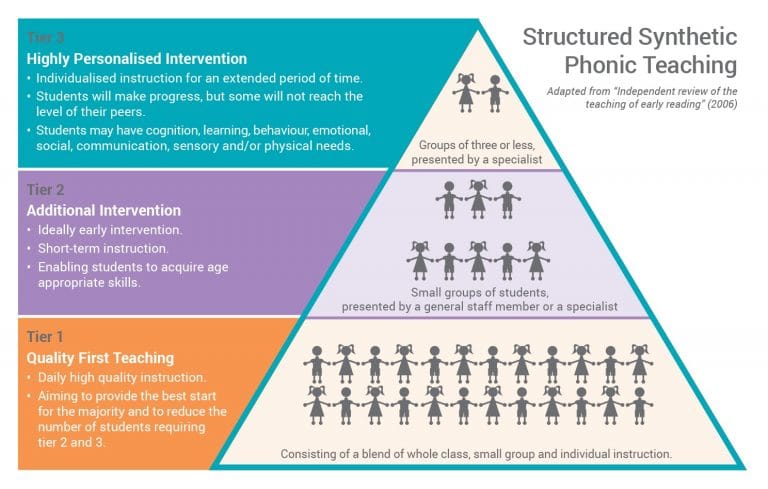AUSPELD is a national body comprised of representatives from various state SPELD associations and a recognised Global Partner of the International Dyslexia Association. Each SPELD organisation is extremely busy catering for large numbers of students and families. While the SPELD’s deliver assessments and diagnose dyslexia, they also advocate best practice. The SPELD’s act to encourage evidence-based processes and programs in schools to prevent students from acquiring the diagnosis of dyslexia.
PLD has a positive working relationship with SPELDs in various states. Many of the SPELD’s have been supplied with a full collection of the PLD programs for their libraries. PLD also collaborates annually with various SPELD’s to deliver workshop presentations throughout Australia.
What Does AUSPELD Recommend?
AUSPELD provides recommendations on evidence-based programs that are backed by current research, linked to improved academic results, and supported by independent reviews of the effectiveness of the program. This allows schools to make informed choices on the programs they implement, thereby preventing the number of students with a learning difficulty diagnosis.
AUSPELD applies the three-tier approach to implementing Structured Synthetic Phonics (SSP) in schools. This is explained in the graphic below:

Source: https://dera.ioe.ac.uk/5551/2/report.pdf
In 2017, PLD was identified by AUSPELD as a recommended Tier 1 (whole class) program and a Tier 2 (small group) evidence-based Structured Synthetic Phonics (SSP) program.
AUSPELD recommends PLD’s literacy range because it utilises a systematic sequence of teaching synthetic phonics and includes explicit phoneme-grapheme teaching, reading and writing (dictation) learning tasks, and the introduction of high frequency, phonetically irregular words in a structured sequence.
In 2019, the Dyslexia-SPELD Foundation compared PLD with other evidence-based SSP programs within the publication The Bulletin. See how PLD compares to their list of eight recommended programs here.
What is a Three-Tier Approach to Implementing SSP in Schools?
Wave 1 (or Tier 1) Programs: Students require explicit, systematic targeted classroom instruction from their junior primary years. This involves the skilful delivery of an evidence-based program at a whole class and small group level so that as many children as possible achieve a positive start to literacy. This is PLD’s area of strength, in fact, PLD originally stood for ‘Preventing Literacy Difficulties’. The outcomes for students are inevitably highest when evidence-based instruction is skillfully delivered from the earliest years in education. PLD’s Teaching Sequence Manuals ensure a systematic, evidence-based approach to the teaching of synthetic phonics is implemented.
Wave 2 (or Tier 2) Programs: Even when classroom teachers skillfully implement Wave 1 programs, a group of students will always require Wave (or Tier) 2 teaching. When delivered in a small group and at the earliest point of experiencing the difficulty, the students receiving an appropriate intervention program have the potential to catch up to their age-matched peers. Early intervention is critical. This can be delivered by a specifically trained education assistant or a literacy support teacher. PLD’s programs can be used to effectively provide Wave 2 small group programs.
In addition, PLD’s screening and tracking tools ensure students requiring Wave 2 intervention are identified as soon as possible. To assist schools all screens are available to download directly from the PLD website. Screens such as these quickly identify the targeted instruction that students require and assist teachers to establish a plan for intervention.
To strengthen the consistent implementation of PLD’s SSP Tier 1 and 2 programs, PLD advocates for the schoolwide use of the PLD Tracking Sheets. Following the schedule of screening & tracking means that termly testing data is entered into the specially designed spreadsheets and is an efficient and reliable method of identifying underperforming classrooms and students so support can be provided where and when it is needed. PLD reminds schools that without adequate training, the implementation of PLD programs can be compromised. PLD offers in-person and online professional learning opportunities Australia-wide.
Wave 3 (or Tier 3) Programs: These students typically present with a range of cognition, learning, behavioural, emotional, social, communication, sensory and/or physical needs. They have the potential to progress but require intensive and highly-personalised instruction over the long term and it is unlikely they will match their age-appropriate peers. Wave 3 programs are typically delivered in pairs or individually. While some schools selectively apply some of the PLD programs to Wave 3 students, AUSPELD identifies other programs (typically direct instruction programs) that are more likely to have broader efficacy to this diverse high-need group.
PLD’s schoolwide literacy approach and variety of support resources can ease the pressure on schools and teachers, and provide the majority with an effective and evidence-based Structured Synthetic Phonics program that ensures all students (Tier 1 & 2) receive quality literacy instruction.
At PLD we are always available to help you achieve the best possible literacy outcomes for your students. If you have any questions about this blog or anything else we do here at PLD, get in touch with us through our chat icon in the bottom right of the screen or mail@pld-literacy.org.



 print
print





